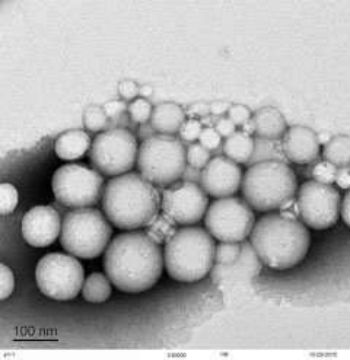|
NOVIDADES
The researchers believe their findings, published in the journal Advanced Materials ("A Dual Immunotherapy Nanoparticle Improves T-Cell Activation and Cancer Immunotherapy"), offer a promising new nanotechnology-based delivery method for an immunotherapy combination.  Nanoparticles loaded with the dual immunotherapy platform. Créditos: Advanced Materials
Immune cells called T-cells can fight and kill tumors, but they have regulatory signals that limit their effectiveness. Treatments called checkpoint inhibitors have been developed to "release the brakes" on immune cells, and have been shown to be a powerful tool to fight lung cancer and melanoma for a subset of patients. Clinical trials have launched to test combining checkpoint inhibitors that release the immune system's brakes with treatments designed to send "green light" signals to boost the immune response. UNC Lineberger researchers developed a mechanism that combines these two compound types on a single nanoparticle with the goal of producing better results. "Our immune cells have both positive and negative signals, like red lights and green lights," Wang said. "It's part of the balance of the immune system -- if you get too much immune activation, you get autoimmune disease. If you go the other way, the lack of immune suppression can give you tumors. We are studying a combination of treatments that both send green light signals to attack, and to block red light signals." In their study, Wang and his colleagues used a nanoparticle to combine a checkpoint inhibitor with aOX40, or anti-tumor necrosis factor receptor superfamily member 4. Since they also believe that radiation treatment can help stimulate T-cells, they added a "priming dose" of radiation. The combination stimulated T-cells at higher rates in laboratory studies than antibodies delivered separately. In tumor models, binding together immunotherapies with a nanoparticle was more effective at attacking tumors than when the compounds were delivered separately. In animal models of melanoma, treating mice with the combination-nanoparticle treatment and given radiation produced the highest immunotherapy response rates, and a cure rate of 30 percent. They also found greater control of breast cancer in laboratory studies using the combination, and increased survival time. "These results will help us build better delivery systems to maximize the potential of immune-boosting therapy for cancer," said UNC Lineberger's Benjamin Vincent, MD, assistant professor in the UNC School of Medicine Division of Hematology and Oncology. University of North Carolina. Posted: Apr 25, 2018. |
|||||||||||||||||||||||||